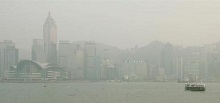Hong Kong’s air quality has improved since the publication of the last plan in 2013 – pollutant levels overall have fallen by up to 50 per cent and visibility increased 40 per cent over the past five years.
Hong Kong has set itself a new target to reach the same standards of air quality as major international cities such as Tokyo and Paris by 2035.
Unveiling the Clean Air Plan for Hong Kong 2035 on Tuesday, Secretary for Environment Wong Kam-sing said the city would aim to fully comply with all World Health Organization standards in this area over the long term, without specifying a timeline for doing so.
Wong said Hong Kong’s air quality had improved since the publication of the last plan in 2013, with pollutant levels overall falling up to 50 per cent, while visibility increased 40 per cent over the past five years.

“There will be three challenges on the way: reducing nitrogen oxide emissions on the roadside, marine emissions and ozone levels,” Wong added.
The latest blueprint highlights six action areas including green transport, clean energy, scientific management on air quality monitoring systems and collaboration within the Greater Bay Area. The latter refers especially to the monitoring of ozone levels, seen as the greatest problem associated with Hong Kong air quality.
Hong Kong aims to be on a par with “major international cities” for air quality by 2035, according to the document.
But Tse Chin-wan, the environment undersecretary, specified Tokyo and Paris as examples of the modern cities that Hong Kong was seeking to emulate when tackling air pollution.
“Currently, we are comparable to Asian cities such as Taipei and Singapore. But we still have a lot to catch up with Tokyo and Paris, which are much better than us.”
Hong Kong’s Clean Air Plan from eight years ago set targets to reduce pollution by 2020, focusing on tackling emissions from vehicles, vessels and power plants.
That HK$11.7 billion plan also required a review every five years of the city’s air quality objectives, which set the concentration limits for pollutants and the number of times the levels can be exceeded in a year.
The most recent objectives will take effect in 2022, but the city is only likely to reach the targets by 2025.
Since the plan came into action, Hong Kong has largely managed to bring down the concentration of major pollutants such as sulphur dioxide and fine particulates such as PM2.5 and PM10.
But another pollutant, ozone, has continued to vex the city’s policymakers and scientists.
Ozone is formed when nitrogen oxide emitted by vehicles mixes with elements known as volatile organic compounds (VOCs), which can come from a variety of sources including paint, solvents and cosmetics.
Sunlight and oxygen speed up the reaction, resulting in smog that can cause eye irritation and serious respiratory illness.
The concentration of ozone has nearly doubled in the past two decades, and the Hong Kong government announced last year it would be undertaking a three-year study to understand how ozone forms and spreads across the Greater Bay Area including Hong Kong, Macau and Guangdong.
Clean Air Network, a local green group focusing on air quality, in April urged the government to switch to an exposure-based mechanism for managing air pollution by setting goals based the health risks facing residents.
It also called on the government to publish the city’s “hotspots” for air pollution exposure, enabling residents to gauge the risks to their health.
Meanwhile, the city is expected to bring its air pollution control plan in line with its climate change policies, which set the aim of Hong Kong becoming carbon neutral by 2050.
Tackling air pollution, which is largely caused by the burning of fossil fuels in vehicles or for generating power, will also help to cut emissions of carbon dioxide, the main greenhouse gas contributing to global warming.
Source: Intellasia 30-Jun-2021
Background: Air Pollution in China’s Hong Kong SAR

Air quality is a major concern in Hong Kong, and the local Government is undertaking a number of initiatives to improve it.
Hong Kong’s air pollution is mainly contributed by motor vehicles, marine vessels and power plants. The two greatest challenges are local street-level pollution and regional smog. Diesel vehicles, particularly trucks, buses and light buses, are the main source of street-level pollution. Smog is caused by a combination of pollutants mainly from motor vehicles, industry and power plants in Hong Kong and the Pearl River Delta. The Environment Bureau released “A Clean Air Plan for Hong Kong” in March 2013 which sets out in detail the various measures to tackle air pollution from power plants, land and sea transport, and non-road mobile machinery and to strengthen collaboration with Guangdong to deal with regional pollution. A progress report was published in June 2017 which gave an account on its implementation and achievements. The Environment Bureau plans to release a new Clean Air Plan by mid-2021 with a view to formulating long-term plans to further improve the city’s air quality.
The Government has been working hard to reduce emissions. As of 2019, a comprehensive programme to reduce street-level pollution had lowered the roadside levels of nitrogen dioxide, respirable suspended particulates, fine suspended particulates and sulphur dioxide by 19%, 58%, 54% and 81% respectively compared with 1999.
In March 2021, the Environment Bureau announced the first Hong Kong Roadmap on the Popularisation of Electric Vehicles, setting out the long-term policy objectives and plans to promote the adoption of electric vehicles and their associated supporting facilities in Hong Kong.
Source:
https://www.gov.hk/en/residents/environment/air/airquality.htm
Leave a Reply
You must be logged in to post a comment.